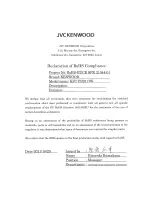
2. Introduction
4
VSXNET Subwoofer Operation Manual rev 2.0.0
2. Introduction
Designed, engineered and built in the United Kingdom, the VSXNET Series from Tannoy comprises of one
band-pass and two direct-radiating subwoofers for demanding professional and commercial sound applications.
Within the VSXNET Series, system designers can choose from a variety of sizes, power levels and low frequency
characteristics to suit particular requirements.
As indicated by their respective suffixes, the VSXNET 12.2BP is a band-pass device, while the VSXNET 15DR
and VSXNET 18DR are direct radiating models. The three band-pass model incorporates Tannoy’s latest
engineering philosphies in band-pass enclosure design, optimising tonal balance and harmonic output through
precisely engineered enclosure geometry and innovative transducer design.
For ease of installation, connections are on integrated, recessed termination panels equipped with both
NL4 speakON
®
and barrier strip connectors. The speakON connectors are angled and recessed to allow flush
mounting to a wall or ceiling.
All VSXNET Series subwoofers are housed in rugged, durable birch ply enclosures with ergonomic Integrip™
carry handles and an integrated pole-mount recess. Coupling VSXNET Series subwoofers to VX and VXP Series
full-range loudspeakers via the optional VTH pole mount facilitates portable PA applications without need for
tripod stands.
3. Unpacking
Each Tannoy VSXNET Series subwoofer is carefully tested and inspected prior to shipment. After unpacking,
please check for any exterior physical damage, and save the carton and any relevant packaging materials in
case the unit again requires packing and shipping. In the event that damage has been sustained in transit, notify
your dealer and the shipping carrier immediately.
4. Preliminary Recommendation
VSXNET Series subwoofers can produce high sustained output levels for long periods of time. If users are in
close proximity, these levels could lead to permanent hearing damage. Because Tannoy loudspeakers
have a natural-sounding, flat frequency response and very low distortion, users may not be aware of the potential
hazard. For continuous exposure to high levels, we recommend use of a sound level meter to ensure noise
levels are within safety limits. The meter should be capable of integrating levels over a period of exposure in
conformance with noise control standards.





































